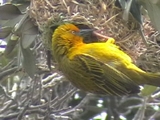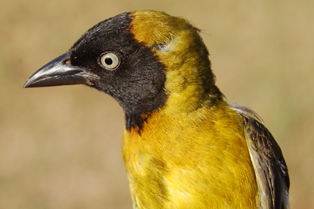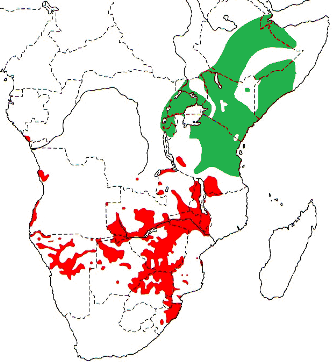Weaver news
|
The Lesser Masked Weaver Ploceus intermedius is a widespread weaver in eastern and the northern parts of southern Africa (see map below, based on Birds of Africa). It occurs in a variety of habitats including acacia savanna, bushveld, open woodland and riverine trees, preferring areas close to water and also human habitation. The adult male in breeding plumage (right) is yellow with a black mask, pale eye and thin bill. Females (below) and non-breeding males are dull coloured, with a pale eye and blue-grey legs. Many subspecies have been recorded but currently there are two accepted subspecies:
The Lesser Masked Weaver feeds on insects, especially caterpillars, termites, and grasshoppers. It also feeds on nectar (mainly of aloes), mulberries, and small seeds. This species is polygynous and a male can have 2-3 females simultaneously, and probably several more in a breeding season. Nests are usually very close together, and sometimes are suspended from other nests. Colonies may be monospecific or mixed with a variety of other weaver species. Nests have a short, narrow entrance tunnel. Nests look untidy due to short lengths of material sticking out.
There are 62 PHOWN record for this species, but only two of these are from the nominate subspecies (see phown 2366 and phown 2481). Many more records are needed of this common species, especially with nest counts. Submit any weaver nest records to PHOWN (PHOtos of Weaver Nests) via the Virtual Museum upload site. Photo (right): male at closely packed nests, from phown 3132. PHOWN summary Previous Wedn: Red-collared Widowbird Full weaver species list |













 Nests are built by the male, and lined by the female, although sometimes no lining is added to breeding nests. Nests are placed in trees, reeds, roof edges of buildings, or from telephone wires.
Nests are built by the male, and lined by the female, although sometimes no lining is added to breeding nests. Nests are placed in trees, reeds, roof edges of buildings, or from telephone wires.